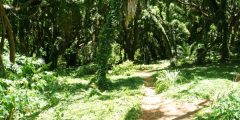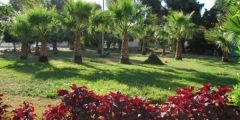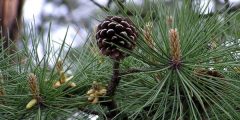What is a manchineel tree?
The Manchineel tree is a member of the Spurges family, and is one of the most toxic trees in the world. Its toxicity reaches such an extent that the smoke emanating from its burning wood is irritating to the eyes.
The latex emitted from its leaves and bark also causes skin inflammation. The manchineel is a round-shaped tree, reaching a height of 12 m, and a trunk thickness of 60 cm. It is distinguished by its long, oval, shiny leaves with a leathery texture and yellow-green colours.
As for its fruits, they have a beautiful smell similar to apples, but they are highly toxic, as the fruit contains a hard core containing 6 to 9 seeds. Its wood is also used in the manufacture of furniture, after it is cleaned and dried well under the sun to get rid of traces of the poison.
History of the Manchineel Tree
The manchineel tree is mostly native to the sandy beaches of the region Caribbean Sea And the Gulf of Mexico. It is possible that the tree was known to the indigenous peoples of the Americas for centuries, but with no records from these peoples it is difficult to confirm the length of time.
The first time the tree entered the historical record was in the late 1521th and early XNUMXth centuries with the arrival of the Spanish conquistadors. In XNUMX AD, explorer Juan Ponce de León led the first European expedition to Florida, returning eight years later to colonize it.
Read also:Plant growth stagesTo counter this attack, the Caribbean Indians in South America dipped their arrows and poisoned the water supply using the sap of the manchineel tree, in an attempt to hinder the Spanish advance. Ponce was injured by one of the poisoned arrows in his thigh during the battle and died from his wounds.
The Spaniards called the manchineel tree “the little apple of death,” and although the early conquistadors avoided eating the tree’s fruit, they continued to suffer from its poisonous effect in clashes with the Caribbean Indians.
Toxicity of the manchineel tree
The manchineel tree is classified as one of the most dangerous and most toxic trees in the world, according to the Guinness Book of World Records. The toxicity is not limited to its fruits only, but also includes parts of the entire tree. Some of these parts have a fast-acting degree of toxicity whose effects appear in an instant, while the poison takes time to develop. Other parts take some time until its effects appear.
The tree secretes a thick, milky juice that comes out of its leaves, stem, and fruits. Contact with this juice leads to the appearance of ulcers and severe inflammation of the skin, and eating its fruits or leaves can lead to abdominal pain, vomiting, bleeding, and damage to the digestive system.
Smoke resulting from burning its wood or rubbing the eyes after touching its leaves causes temporary blindness, and standing near the tree causes suffocation, as the respiratory tract closes as a result of the tree’s toxic smell. When inhaling the toxins of the manchineel tree or entering the poison into the bloodstream, this is likely to lead to To death.
Read also:The phenomenon of desertificationUses of the manchineel tree
Despite the high degree of toxicity in the manchineel tree, it can be beneficial and can be used in several things, such as the following:
- Reducing the effects of coastal erosion
The manchineel tree usually grows in dense forests in coastal areas and swamps, and provides an important fortress that prevents soil and beach erosion through its deep roots and density, which makes it well suited to reduce the effects of erosion, as it causes a large financial loss and loss of coastal property.
- Furniture Industry
Scan has long been used Caribbean islands The manchineel tree is used in the manufacture of furniture wood. Despite the strangeness of making furniture from a poisonous tree, it can grow to approximately 15.2 metres. It can also provide an abundant amount of wood in places where these resources are scarce. However, the wood must be dried for several days. Under the sun to make the sap harmless and usable in furniture making.
Read also:What are basidiomycetes?- Treating some diseases
In indigenous traditions, such as those of the Caribbean Indians, the gum of the manchineel tree was used as a diuretic, and its sun-dried fruit was used to treat edemas.
- Windbreaks
Thanks to the manchineel tree's towering height of up to 15 metres, the manchineel tree works As natural windbreaks, they provide a useful service against rising sea levels and large Atlantic storms.









